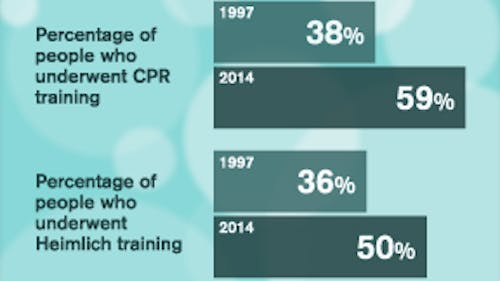Poll shows positive results for CPR, Heimlich training in NJ

Learning CPR and the Heimlich maneuver could save the life of a loved one in the future, said Marian Passannante, a professor in the New Jersey Medical School and the School of Public Health.
“The person you save is likely to be someone you know and love. Most cardiac arrests occur in the home or a hospital, and most choking incidents occur in the home,” she said.
The Eagleton Institute of Politics recently conducted a study of the public’s awareness and training for CPR and the Heimlich maneuver to treat choking victims that showed positive results for both categories.
Since their previous survey in 1997, training for CPR has increased from 38 to 59 percent, and training for the Heimlich maneuver has increased from 36 to 50 percent, according to the press release.
David Redlawsk, director of the Eagleton Center for Public Interest Polling, said this survey is part of a new series on public health-related issues.
The survey clearly showed that awareness of emergency procedures has increased, he said.
According to the press release, 96 percent of the 871 respondents have heard of CPR, and 90 percent have heard of the Heimlich maneuver.
“Now the state legislature has mandated CPR training in high schools, but that does not affect the poll yet,” Redlawsk said.
Passannante said CPR involves pumping a victim’s chest if his or her heart stops. Although the chance of survival in cardiac arrest is generally low, standard CPR can double or triple the rate of survival.
The Heimlich maneuver involves a short thrust to the belly just below the chest, she said.
Most first aid and babysitting courses teach CPR and the Heimlich maneuver, she said.
“It’s good to see that kind of large increase, but it’s still not at 100 percent,” she said.
The poll showed some disparity between different races and age groups. For example, white individuals and women are five percentage points more likely to be aware of the procedure.
Middle-aged respondents were more likely to have heard of CPR than millennials, but millennials were 30 points more likely than senior citizens to be trained in the procedure, according to the press release.
For the Heimlich, the divide in awareness between whites and other races was 15 percentage points apart. But nonwhites were more likely to be trained the procedure.
Overall, 15 percent of respondents had used CPR and 19 percent of respondents had used the Heimlich maneuver. In addition, the Heimlich maneuver reportedly aided 6 percent.
In both cases, more educated New Jersey residents were more likely to be aware of and trained in the procedures.
“I think the education issue is pretty clear — there is going to be higher awareness among people who are better educated,” Redlawsk said.
The training disparity among age groups also makes sense, he said. The initiative to train residents in high schools and programs has only originated in the past few decades.
Passannante said although she did not have specific data, the rates of use and aid sounded reasonable compared to the anecdotal information she has heard, especially since the poll measured lifetime use.
“Seeing someone choking is not that unusual,” she said.
Peter Heimlich, son of the inventor of the Heimlich maneuver, Henry Heimlich, applauded the efforts of the poll, but believed it did not accurately conform to current guidelines.
More than a decade ago, the American Heart Association and the American Red Cross replaced the term “Heimlich maneuver” with the term "abdominal thrust," he said in an email.
The poll only used “Heimlich maneuver,” which shows how widespread it has become despite the guidelines, he said.
“No big deal, but to avoid confusion, it might have been useful to include both terms,” he said.
Editor's Note: A previous version of this article incorrectly stated that the American Heart Association and the American Red Cross replaced the term “Heimlich maneuver” with the terms “back blows” and “chest thrusts.”



